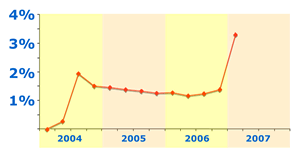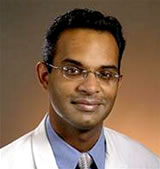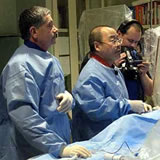|
Is Radial
Angioplasty at a Turning Point in U.S.?
New Studies Confirm
Increased Safety of Wrist Technique for Stents and Angioplasty;
Training of Cardiologists is Key Issue
|
 |
September 25, 2008 (updated
from September 24) -- Two recent large-scale studies confirm
what a small but growing number of interventional cardiologists
have
seen in their
own practices:
for the proper patients, catheterizations and angioplasties performed
from the wrist (radial) artery are safer than those performed from
the groin
(leg)
artery, with no difference in procedural
success. As previously reported by Angioplasty.Org, the
M.O.R.T.A.L. Study which looked at a registry of 33,000 Canadian
patients, showed 50% less blood transfusions and accompanying
reductions in mortality for patient done radially. A study
from Duke,
published in the current journal JACC Interventions, looked
at 593,094 U.S. patients and found that radial patients
experienced 58%
less bleeding complications.
Even an editorial in the current British Medical
Journal Heart asks the questions: "Is radial approach the gold standard
for
PCI?"

Percentage
of cases done via the
transradial approach in U.S. |
|
The radial technique is used
far more outside of the U.S., up to 35-50% of the time in Europe,
Japan, and India.
But an interesting trend
seen in the Duke study was a recent and significant increase
in the
use
of
the
transradial
approach, which almost doubled in the first quarter of 2007,
the last data used in the study. |
Dr. Sunil V. Rao of Duke commented to Angioplasty.Org
on this trend:
"Radial is gaining.
We saw this in our paper: in the last quarter of 2007, we saw
an
up tick in the use of radial. And I think the timing is right.
There's
a lot of attention being paid to bleeding complications and their
association with mortality. The focus has really been
on the pharmacological therapy...but what I think a lot of people
have forgotten is that the majority of bleeding complications
in
patients undergoing stenting is related to the
access site.
"I think the radial approach has been in the
background for a long time,
but now
we have a study showing that the radial approach is associated
with reduced mortality." |
|

Sunil V.
Rao, MD, FACC
Duke
Univ. Medical Center |
More Comfortable for Patients
Most patients who have a cath or angioplasty must lie still on their
backs for hours, to allow bleeding from the femoral
artery to completely stop (hemostasis). Ironically, the chief discomfort
experienced by
a patient, whose coronary artery has been cleared of a major blockage
without bypass surgery, is the leg pain where the catheter
was inserted. And the back pain ensuing from lying still. Bleeding,
vascular or nerve trauma complications occur in three to six
or more patients out of a hundred: some are just minor hematomas,
but some can require a transfusion.
With the radial or wrist
approach, bleeding complications approach zero and nerve trauma
is almost non-existent. Hemostasis can be achieved very quickly,
and the patient can sit up and walk within minutes after the procedure.
As Dr. Howard Cohen of Lenox Hill Hospital in New York told Angioplasty.Org,
"Patients really prefer it. 95% of
people who've had it both ways would say 'I'm coming back to you,
Dr. Cohen
because
I
like this transradial a lot better than the other way!' (
Dr. Cohen was profiled on yesterday's CBS
Network "Early Show", discussing the "New Angioplasty" --
namely the radial approach.)
Barrier to Increased Use: Training
Since the radial technique is safer and more comfortable, then why
isn't it used more? One of the biggest roadblocks to wider use
is that, while all cardiologists are trained in the femoral technique,
very few are exposed to the radial approach. This training is
non-existent in medical school and very scattered once the
physician has specialized in interventional
cardiology
in a
Fellowship
program.
If the cardiology group does not practice radial, the Fellow will
not learn it.
Radial
training programs have been held around the world for years,
in India, Japan, China, Europe -- but more are beginning to
crop up in the U.S.
Terumo, a company that makes specialized
catheters and related equipment for the radial approach has
been sponsoring two-day hands-on seminars at Lenox Hill Hospital
and St. Vincent's Hospital in New York -- and these courses
have filled up weeks in advance. The Company also is sponsoring
a
number of activities at the upcoming TCT meeting in October.
Dr. Rao commented on the problem: "It's hard to learn new
techniques once you get into practice. So I'm a firm believer
that
fellows
need
to be
exposed to it during their training. And that's what we do,
We insist that the fellows do at least one radial case a week
at the very minimum while they're training with us, so they
are comfortable with us and not have their heart rate increase
when they have to do one." |
|

Drs. John
Coppola and
Shigeru
Saito during a
transradial case
at a
St. Vincent's training course |
When Angioplasty.Org asked Dr. Rao if groups
like the American College of Cardiology (ACC) and the Society for
Cardiovascular Angiography and Interventions (SCAI) ought to get
involved in training cardiologists about the transradial approach,
he replied:
"You're absolutely
correct. The professional societies have to take a leading
role in this. The data are very
clear. They need to adopt this into their practice guidelines,
in addition to saying, 'Here are techniques that you can
use to reduce bleeding complications, dose your drugs, etc.',
I think they should include a section on radial approach, talk
about the
advantages of it. I think the
professional societies would do well to actually put on courses
for practicing
cardiologists on how to do the radial technique and tips and
tricks and how to troubleshoot.
"What happens is the first few times
that people start doing the radial approach, they say,
'This is really onerous and I'm having trouble negotiating this
curve. Forget it -- I'm just going
to go to the femoral approach.' And that's because they haven't
gotten any formal training on how to troubleshoot -- just
like you have
to troubleshoot the femoral approach oftentimes, too. So
you're absolutely right and that's something that no one's
really
mentioned before,
that's the role of the professional societies in helping
clinical cardiologists and practicing cardiologists adopt
this technique
into their practices. I think that's really important."
About the Radial Access Center on Angioplasty.Org
To
assist in educating the professional and patient population in the
U.S.
about
the this
technique,
Angioplasty.Org has created the "Radial
Access Center for Transradial Approach", a special section
devoted to information and news about the transradial technique,
for both
patients and physicians. The Radial Center features interviews
with leading practitioners of the radial technique, such as Drs.
Jeffrey
Popma, R. Lee Jobe, John Coppola, Shigeru Saito, Kirk Garratt and Howard
Cohen.
For patients there is also a "Hospital
Locator" that lists U.S. centers practicing radial
angiography.
Reported by Burt Cohen, September
24, 2008; updated September 25
|



